From clues to news
Thumbs up to Einstein
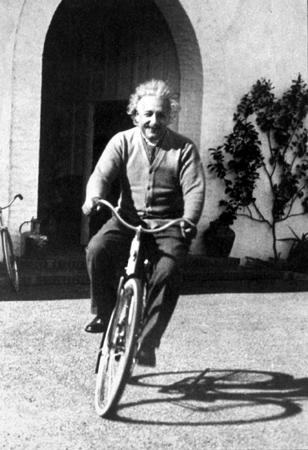
All relative?
Remember the big question at the start of your investigations: What is the theory of relativity all about?
You now have a lot of the information needed to answer this.
Here are the clues you found during the science trail at Glasgow Science Centre:
orbit, straight line, spinning, density, everything falls towards the ground at the same rate.
What kind of story do we get when we put these together?
Points of view

Lots of people have the wrong idea about the theory of relativity. They think it says "everything is relative so it all depends on your point of view".
But relativity says exactly the opposite of this.
Relativity says that for science to be possible there must be things that don't depend on your point of view.
The laws of nature have to be the same whether you are on Earth or Alpha Centauri, whether you're sitting still or blasting across interstellar space, whether you're a human on a roundabout or a blue dinosaur swimming up the Clyde in a brown suit.
The exactly-the-same theory isn't as snappy a name as relativity theory. But it's closer to the truth.
Let's see how this works out.
Straight lines and curved
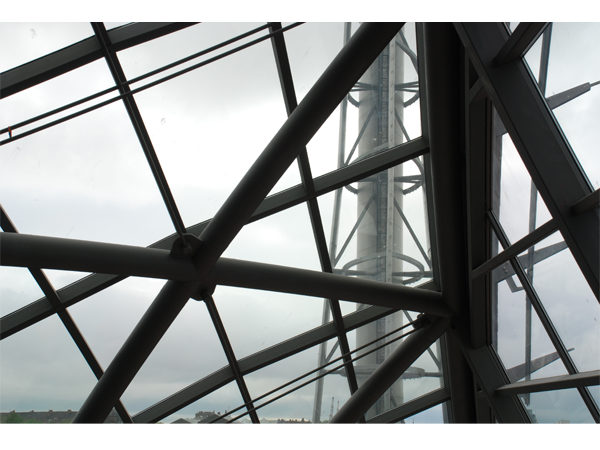
Scientists have known for centuries that objects move in a straight line at steady speed unless a force pushes them off.
But you know from the science trail that objects on roundabouts don't move in straight lines.
Before relativity, if scientists wanted to work out how things move, from the point of view of a person on a roundabout, they had to do something strange. They had to include "fictitious forces" in their sums - forces that don't exist.
Relativity does something that seems even stranger at first. But it works out beautifully.
Relativity says that when there are no forces - no real forces - an object always moves in a straight line. Whether it looks like one or not.
Always straight
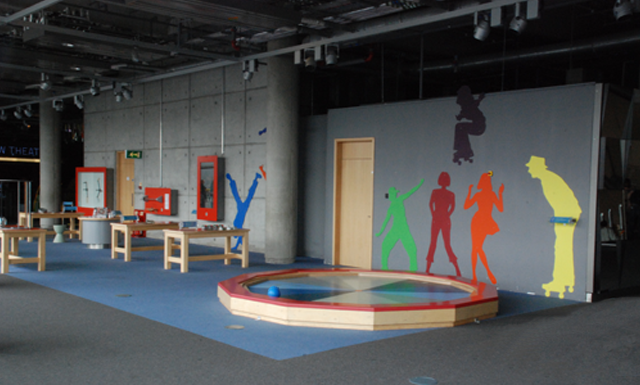
The path of a ball on a roundabout does not look like a straight line to someone on the roundabout. So how can this make sense?
The answer is that it really is a straight line. But it's not a straight line in space. It's a straight line in space-time.
Space has three dimensions. Space-time has four. It's hard to picture and the maths can get complicated. But the idea is really simple:
The way a small object moves, when there are no forces on it, is always a straight line. This is true if you are standing on a spinning roundabout, on solid ground or on the scary surface of a neutron star.
Here's what Einstein said about this, when he came to Glasgow University in 1933:

"A material particle on which no forces are acting is represented in four-dimensional space by a straight line."
This is one of those exactly-the-same things about relativity that we mentioned earlier.
It's the most important one for gravity.
So how do we get straight lines with gravity?
Gravity well


You've already thought about how the little balls would move around the gravity well if there was no friction to slow them down.
They wouldn't tumble quickly into the hole. They would keep on going. If they started around in a circle they would keep on round in a circle.
Just like the Space Station, the Moon and the Satnav satellites keep going around the Earth. Just like the Earth keeps going around the Sun. Just like the twin pulsars keep going around each other.
Let's take a relativity look at the paths these take.

Einstein had the brilliant but apparently crazy idea (we'll see how he got it later) that gravity is a fictitious force.
Just like the forces that "explain" why things don't move in straight lines on a roundabout.
If that's true then the paths a ball takes in a gravity well with no friction are straight lines. The way a satellite moves around the Earth is a straight line. The way the twin pulsars move around each other are straight lines.

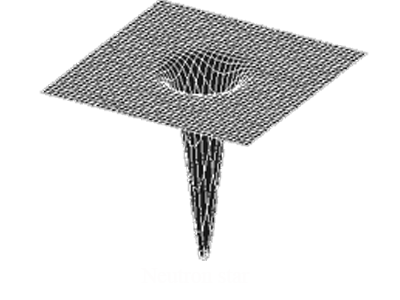
But a straight line - the shortest distance between two points in 4-dimensional space-time - looks different when there's a large mass around.
A large mass like a planet or a star changes the shape of nearby space and time.
We can't see the shortest distances now as straight lines. But that's because human brains evolved to help us find food on the African plains - not to see space-time near a star.
Stone-age brains
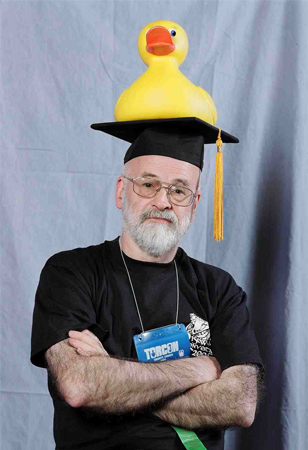
Here's the problem. It's hard to talk about what the world is really like "using a language originally designed to tell other monkeys where the ripe fruit is."
Who said that? Terry Pratchett.
And he's spot-on. It's why physics seems hard sometimes.
The human brain has never known atoms or galaxies. None of our ancestors travelled at light-speed or tried to park their spaceships near a black hole.
High speeds were those of an antelope we were hunting or a cheetah chasing us. Force came from a fist, a wooden lever or a thrown spear. Mass gave weight to a sackful of berries.
So "common sense" tells us things about the world that are just plain wrong - especially when we look beyond our small blue planet.
Falling feathers
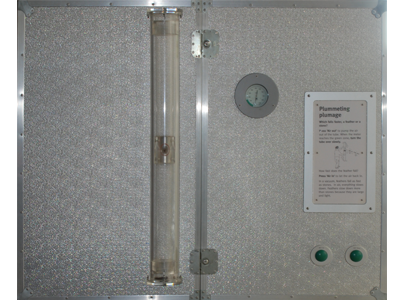
Maybe the most important experiment of all time?
It's a tough billing to live up to. Let's see why it might be true.
Scientists have known for centuries that objects dropped together hit the ground at the same time - as long as air doesn't get in the way. With no air resistance, a peanut dropped from a plane would fall as fast as a ten tonne tank.
It's not what most people expect. But you've seen at the Science Centre that it's true.
The question is why.
Before relativity the answer was "pure coincidence". The gravity force on a body - its weight - happens to balance its reluctance to move - its inertia.
Always. Whether the body is big or small, made of fur, foam or feathers.
The tank has a much bigger weight than the peanut. But it's a lot harder to shift. By coincidence the two balance exactly - for the tank, the peanut and every other object. So they all hit the ground at precisely the same time.
Einstein didn't buy this coincidence. He believed the experiment was telling us something profound about our world - something our old spear-and-berries brains couldn't quite grasp.
Here's what Einstein said at Glasgow University about everything falling at the same rate:
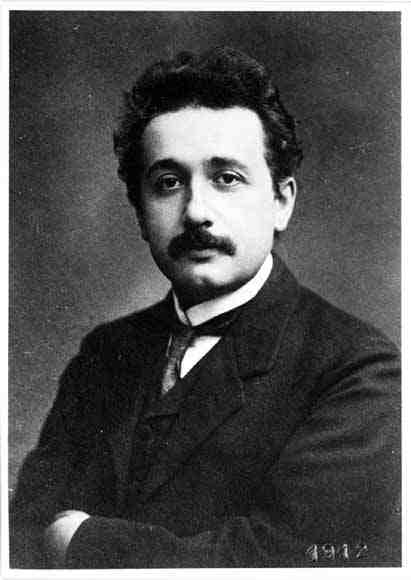
"I wondered how this law could exist and believed that it held the key of the understanding of inertia and gravitation."
This one experiment, Einstein said, made him think so deeply about gravity, roundabouts and forces that it gave him his big idea.
And that was?
That gravity is a fictitious force. Just like the fictitious forces that "explain" why objects don't move in straight lines on a roundabout.
How does that help?
Well if gravity is a fictitious force the puzzle of the plummeting plumage disappears.
There is no coincidence. Weight is just a number that makes the sums come out right.
All bodies, whatever they weigh or are made of, have to follow the same paths near planets or stars, because there is no real force acting on them.
And if there is no force acting on something it follows a certain type of path. Which is?
That's right - a straight line.
The shortest distance between two points in space-time.
Putting relativity to the test
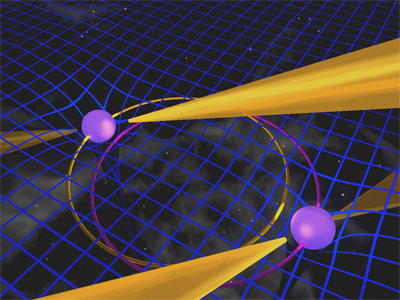
Take a look at the news story, when you get the chance, to see how the MIT research team have been tackling this.
Here's a question to keep in mind while you're reading it:
We haven't mentioned one clue from the science trail yet - namely density. Why do very dense objects give us good tests of relativity?
And one last question before you go (we did say that scientists ask questions):
Imagine you are one of the scientists on the MIT team. What would you like to investigate now?

